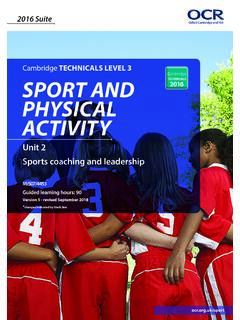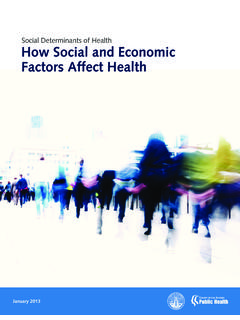Transcription of The Effect of the Physical Learning Environment on ...
1 1/7 The Effect of the Physical Learning Environment on Teaching and Learning Spanning all sectors in Victoria, schools have referenced research in their building design that suggests that particular architecture and design of Learning spaces will contribute to effective teaching and improvements in student achievement. A number of these school were built in the 1970s and 80s. Others are planned over the next few years. In their current budget, the State government has promised a substantial investment in the building and refurbishment of government schools. This is likely to create much discussion about the best Physical Environment for effective teaching for student Learning . In this topic we look at how research can inform and challenge our views about the Effect of the Physical Learning Environment on student achievement and teachers' work.
2 This discussion starter aims to promote the sharing of teachers knowledge and experience on this important subject. The Physical Environment and student achievement Studies about student academic achievement and building condition conclude that the quality of the Physical Environment significantly affects student achievement. 'There is sufficient research to state without equivocation that the building in which students spends a good deal of their time Learning does in fact influence how well they learn' (Earthman, G 2004:18). Desirable designs include having 'friendly and agreeable' entrance areas, supervised private places for students, as well as public spaces that foster a sense of community, with particular attention to the colour used (Fisher, K 2000 in McGregor, J 2004:2).
3 Today's schools must create spaces that students want to go to, similar to the way cafes attract people, rather than the space being purely functional (Bunting, A 2004:12). Other research has acknowledged that 'student achievement lags in shabby school buildings' but go on to say that this research 'does not show that student performance rises when facilities go from .. decent buildings to those equipped with fancy classrooms, swimming pools, television studios and the like' (Stricherz in Higgins et al 2005:36). In one study the significant improvements in the Learning Environment were attributed to the better attitudes to teaching and Learning the improvements in the Physical Environment created amongst all users (Berry in Higgins et al 2005:14).
4 Facilitating teachers' work Decent facilities make additional contributions to teachers work. Siegel has found there was a direct relationship between architecture and the collaboration of teachers. 'The arrangement of space has immediate and far reaching consequences for teacher's ability to effectively and efficiently accomplish daily activities, the formation of social and professional relationships, and the sharing of information and knowledge' (Siegel, J 1999:4). Consideration of the spaces where teachers meet and collaborate is just as important as the design of the classroom (McGregor, J 2004:4). 2/7 But it doesn't all have to be left to the architects. One study concluded that teachers who are more likely to modify their classrooms to produce what they believe is a more effective working Environment are also more likely to collaborate with colleagues in the staffroom (Bissell, J 2004:29).
5 Designing Learning spaces Of course there are many arguments in the research about the optimal teaching and Learning spaces and their contribution to improving student achievement. These range from those who advocate de-schooling pulling down the walls to those who propose open space arrangements, to those whose research reports the benefits of more traditional classroom arrangements. Horne challenges us to 'tear down the school walls' because students are being forced to learn in contexts so different from the world where they are required to put their knowledge to use. His view of schools as being similar to 'fortresses' is the cause of lower levels of parental involvement with schools and prevents the much needed improvement to parent/teacher and parent/parent relationships that in turn contribute to improvements in teaching and Learning (Horne, M 2004:6).
6 Stevenson also advocates schools being opened more widely for community use, but points out the implications of this on materials, design and maintenance (Stevenson, K 2007:3). Advocates of open plan schools argue that students 'should be allowed to learn in ways suited to their individual differences' and that the most effective teaching and Learning strategies allow teachers to work collaboratively with each other and team teach. The traditional classroom boxes with desks lined up in rows impede teachers' efforts to work in teams and have students 'in the flexible and varied groupings necessary' (Mark, J 2001:5). Stevenson and Bunting also favour this approach, suggesting that 'traditional academic classrooms may disappear, replaced by holistic Learning labs and exploratory centres' (Butin, 2000; Keep, 2002 in Stevenson 2007:3).
7 Bunting agrees, saying that 'traditional classrooms must change' and proposes a model of a generic space for students to be co-located with teachers, which are decorated by the students to give them ownership, and teachers and students only move when necessary to access specialised space (Bunting, A 2004:11 12). Weinstein and David question some of the implied benefits of open planning. 'Open space in and of itself does not have a universal Effect ' while others comparing open and traditional environments argue 'the essential elements were the school's educational philosophy and Physical layout, not merely the Physical layout' (Higgins et al 2005:14). Organising classroom space There is a volume of research that suggests 'less attentive and less successful pupils are particularly affected by the desk arrangement, with their on-task behaviour increasing very significantly when seated in rows instead of tables' (Higgins et al 2005:26).
8 At a more erudite level researchers argue that teachers require a good knowledge of their students to implement an effective seating arrangement. Seating arrangements can be territorial (space organised by individual desk ownership) or functional (space organised by 3/7 a specific activity ). There can often be an 'action zone' where an increased involvement between teacher and students occurs across the front and down the middle of the room (Higgins et al, 2005:6 Weinstein 1979:), whereas some favour a horseshoe formation to overcome the fact that often when clustering students, group size and placement can be driven more by furniture and arrangement than pedagogy (McNamara & Waugh, 1993 in Higgins et al, 2005:26).
9 It may be that a 'one size fits all' model or solution is not possible. It seems that different arrangements are required for different teaching and Learning contexts. What researchers do agree upon is that it is imperative for a school to have a clear vision in order to design facilities which can accommodate this (Stevenson, K 2007:3; Higgins et al 2005:14). Physical conditions There is a plethora of research that examines the Effect of the Physical conditions of teaching spaces (which includes seating, furnishings, spatial density, privacy, noise and acoustics, climate and thermal control, air quality, windowless classrooms, vandalism and play-yards, light and colour) on students' engagement, attainment, attendance and wellbeing (Keep, G 2002; Higgins et al 2005; Lackney & Jacobs, 2004; Gump 1987; McGuffey 1982; Earthman 2004; Sundstrom 1987; McNamara & Waugh 1993; and Weinstein 1979).
10 Some interesting contentions about the Physical aspects of Learning spaces include: Temperature, heating and air quality are the most important individual elements for student achievement (Earthman, 2004: 11 16). Chronic noise exposure impairs cognitive functioning, with numbers of studies finding noise-related reading problems, deficiencies in pre-reading skills, and more general cognitive deficits. (Higgins et al, 2004:18). 'Colour remains the topic of some of the most optimistic claims about morale and efficiency' (Sundstrom, 1987:751). According to some research, the choice of the best use of colours is dependrnt on the age of children (brighter for younger students, more subdued for adolescents), as well as differences between males and females (males bright colours, females softer).







